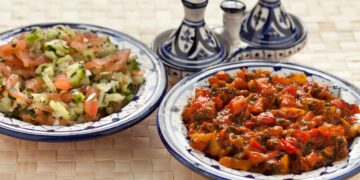In Morocco, bread is more than just food—it is a symbol of culture, tradition, and community. It holds a central place in daily life, accompanying every meal and bringing people together. Bread is deeply rooted in Moroccan hospitality, where sharing a meal is an act of generosity and connection. It reflects the country’s agricultural heritage, with wheat being a staple crop for centuries. Beyond nourishment, bread carries spiritual and social significance, often treated with great respect. Its role in Moroccan households goes beyond the table, representing history, identity, and the warmth of home.
Seasonal Moroccan Breads
Moroccan cuisine is famous for its rich flavors, vibrant spices, and incredible variety of breads. Each season in Morocco brings its own special bread, influenced by local ingredients, climate, and traditions. Whether you’re enjoying a warm khobz in winter or a crispy msemen on a summer morning, Moroccan bread is deeply connected to the rhythm of the seasons.
Here we’ll explore five must-try Moroccan breads, how they change with the seasons, and why they are essential to Moroccan culture.
1. Khobz – The All-Season Staple
Khobz, the classic Moroccan round bread, is a year-round essential. It’s served with every meal, from breakfast to dinner.
Why it’s special:
- Made with wheat or semolina, it has a crispy crust and a soft interior.
- Baked in traditional clay ovens for a unique smoky flavor.
- Pairs perfectly with seasonal tagines, soups, and dips.
Tip: In colder months, khobz is often enriched with anise or barley for extra warmth and nutrition.
2. Harcha – The Perfect Winter Comfort Food
Harcha is a delicious, pan-fried semolina bread that’s especially popular in winter. Served warm with honey and butter, it’s a comforting treat for chilly mornings.
Why it’s a winter favorite:
- The rich, buttery taste provides warmth and energy.
- Often enjoyed with Moroccan mint tea for a cozy snack.
- Can be made thicker in colder months for a heartier texture.
Tip: Add a sprinkle of cinnamon in winter for an extra warming touch.
3. Msemen – A Springtime Street Food Delight
Msemen is a flaky, square-shaped Moroccan pancake that is perfect for spring. As the weather warms up, you’ll find street vendors making fresh msemen in bustling markets.
Why it shines in spring:
- Light and crispy, making it ideal for outdoor breakfasts.
- Often stuffed with herbs and cheese when spring greens are at their peak.
- Pairs beautifully with seasonal fruit preserves.
Tip: Try msemen with orange blossom honey for an authentic Moroccan experience.
Hiking Trails in the Middle Atlas Mountains
The Middle Atlas Mountains are often overshadowed by the High Atlas or the Rif, yet they hold some of Morocco’s...
From Passion to Profession: Turning Creative Skills into Income
In Morocco, more young people are transforming their creative talents into careers. Whether it’s photography, calligraphy, fashion design, or digital...
Young Moroccans Abroad: Balancing Wanderlust and Roots
For many young Moroccans, the dream of exploring the world is irresistible. Whether through study, work, or travel, living abroad...
Networking for Millennials: How to Build Real Connections in Casablanca and Rabat
In Morocco’s fast-paced urban centers, especially Casablanca and Rabat, networking is essential for millennials seeking growth and opportunities. No longer...
4. Batbout – The Ultimate Summer Sandwich Bread
Batbout, also known as the “Moroccan pita,” is soft, fluffy, and perfect for summer. It’s commonly used to make quick sandwiches filled with fresh vegetables, olives, and grilled meats.
Why it’s a summer must-have:
- Light and airy, making it easy to digest in hot weather.
- Can be stuffed with fresh summer ingredients like tomatoes and cucumbers.
- Grilled outdoors for a smoky, irresistible flavor.
Tip: For the best summer experience, fill batbout with grilled sardines, a Moroccan favorite.
5. Rghaif – The Cozy Autumn Favorite
Rghaif is similar to msemen but often folded and stuffed with savory fillings. In autumn, it’s commonly enjoyed with rich, spiced fillings like caramelized onions, spiced lamb, or roasted pumpkin.
Why it’s perfect for autumn:
- Layers of crispy dough capture warm, seasonal flavors.
- Often paired with harira soup as the weather cools down.
- Can be sweetened with dates and nuts for an autumn dessert.
Tip: Serve rghaif with a cup of spiced Moroccan tea for the ultimate autumn treat.
Testimonial from a Food Lover
“I used to think Moroccan bread was just khobz, but after spending a year in Morocco, I discovered how each season has its own special breads. In winter, I loved eating warm harcha with honey, while in summer, batbout sandwiches were my go-to meal. Moroccan bread is more than food—it’s a way of experiencing the culture.” – Lisa, travel blogger & foodie
Conclusion
Moroccan bread is deeply tied to the seasons, offering unique flavors and textures all year round. Whether you’re looking for a cozy winter treat or a refreshing summer bite, there’s a Moroccan bread for every occasion.
Try This: Next time you visit a Moroccan bakery or restaurant, ask what seasonal bread they recommend—you might discover a new favorite!
















Discussion about this post